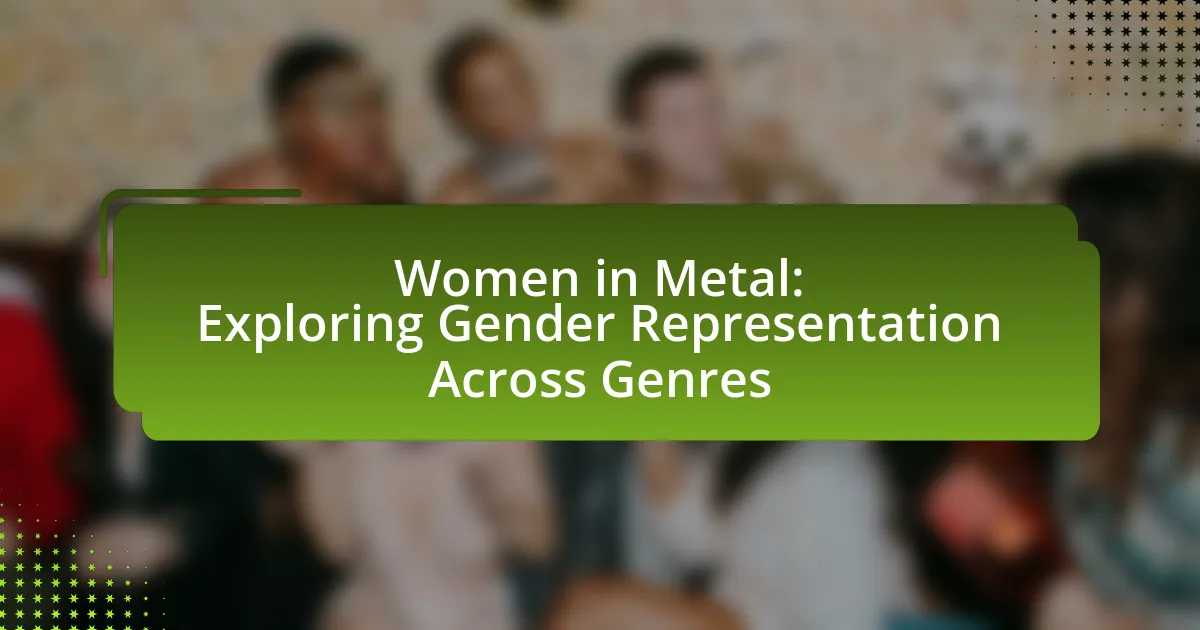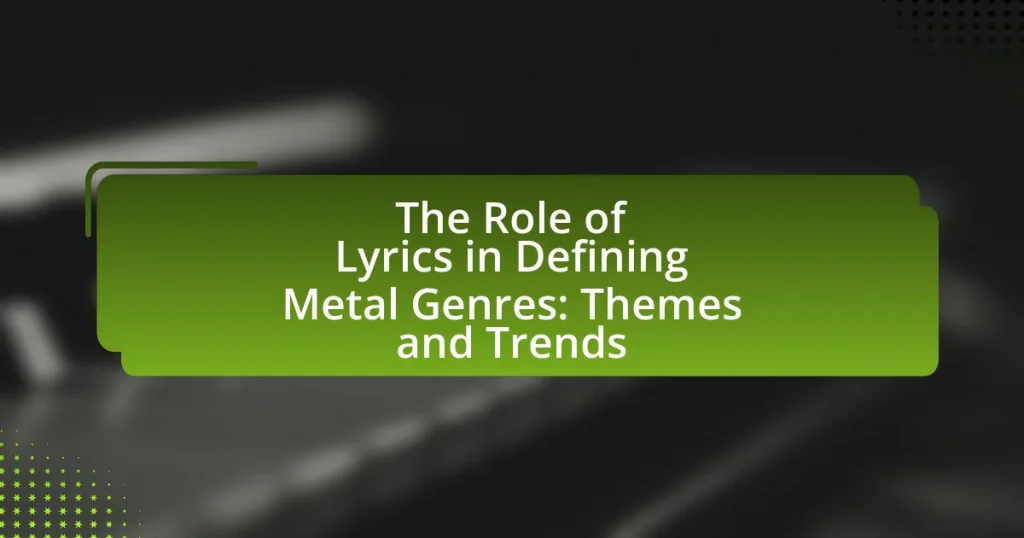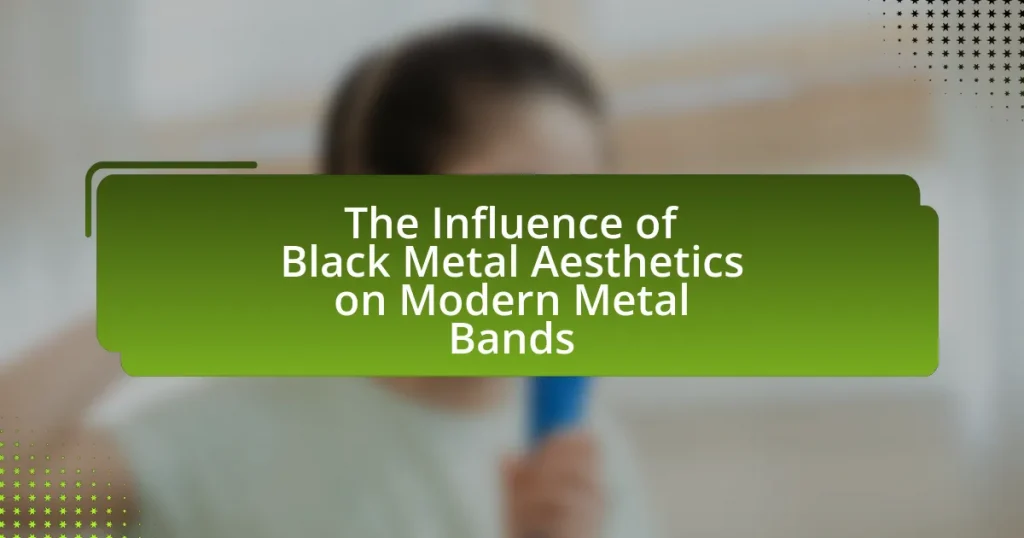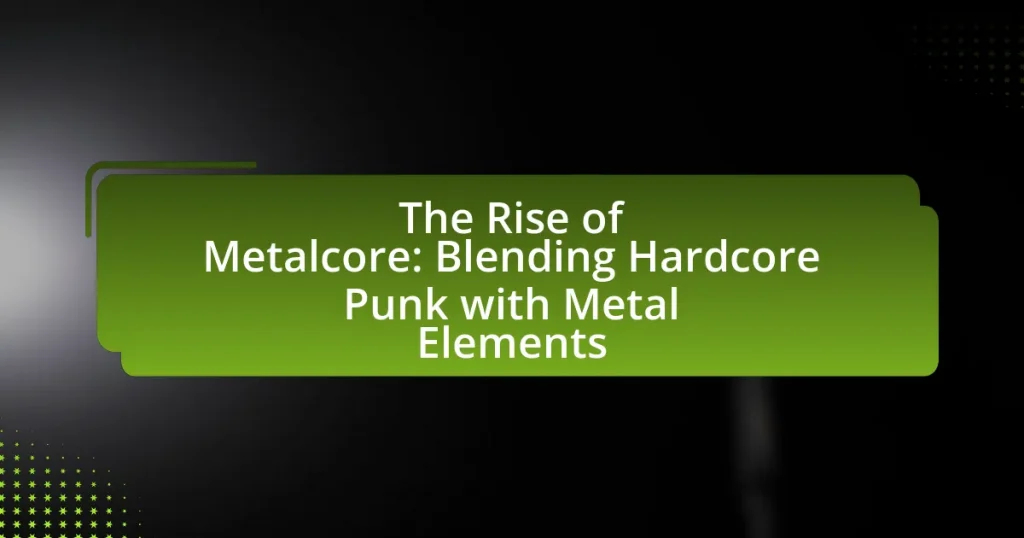The article examines the role of women in metal music, highlighting their significant contributions as performers, songwriters, and influential figures within the genre. It traces the evolution of female representation in metal, from historical milestones to contemporary challenges, including gender discrimination and underrepresentation. The discussion encompasses various metal subgenres, illustrating how women are portrayed and the impact of societal changes on their roles. Additionally, the article addresses initiatives that support women in the metal community and suggests strategies for improving gender representation in the industry.

What is the role of women in metal music?
Women play a significant role in metal music as both performers and influential figures within the genre. Historically, women have contributed to the evolution of metal through various roles, including vocalists, instrumentalists, and songwriters, challenging gender stereotypes and expanding the genre’s diversity. For instance, artists like Doro Pesch, known as the “Queen of Metal,” and bands such as Nightwish and Arch Enemy have showcased women’s capabilities in heavy music, achieving commercial success and critical acclaim. Additionally, studies indicate that female representation in metal has increased over the years, with more women participating in bands and festivals, thereby reshaping the landscape of the genre and inspiring future generations of female musicians.
How has the representation of women evolved in metal genres?
The representation of women in metal genres has evolved from being largely marginalized to increasingly prominent and influential. Initially, women in metal were often relegated to stereotypical roles, such as the “girlfriend” or “muse,” with few female musicians gaining recognition. However, since the late 1980s and into the 1990s, bands like Nightwish and Arch Enemy showcased female vocalists in powerful positions, challenging traditional gender norms. By the 2000s, the rise of female-fronted bands and solo artists, such as Lzzy Hale of Halestorm and Cristina Scabbia of Lacuna Coil, further solidified women’s roles in the genre, leading to greater visibility and acceptance. Studies indicate that female participation in metal festivals and events has increased significantly, reflecting a broader cultural shift towards gender equality in music.
What historical milestones mark women’s presence in metal music?
Women’s presence in metal music is marked by several historical milestones, including the formation of all-female bands in the 1970s, such as The Runaways, which challenged gender norms in a male-dominated genre. In the 1980s, artists like Doro Pesch of Warlock gained recognition, becoming one of the first prominent female vocalists in heavy metal. The 1990s saw the rise of female-fronted bands like Nightwish and Lacuna Coil, which further established women’s roles in metal. Additionally, the emergence of festivals like the “Women in Metal” festival in the 2000s highlighted female talent in the genre. These milestones collectively demonstrate the evolving representation and influence of women in metal music.
How have societal changes influenced women’s roles in metal?
Societal changes have significantly influenced women’s roles in metal by increasing their visibility and participation in the genre. The feminist movements of the late 20th century challenged traditional gender norms, leading to greater acceptance of women in various music scenes, including metal. For instance, the rise of female-fronted bands in the 1990s, such as Nightwish and Arch Enemy, showcased women’s talents and contributed to a shift in audience perceptions. Additionally, the #MeToo movement has prompted discussions about gender equality and harassment in the music industry, further empowering women to assert their presence and influence in metal. These societal shifts have resulted in a more inclusive environment, allowing women to take on roles as musicians, producers, and industry leaders, thereby reshaping the landscape of metal music.
What challenges do women face in the metal music scene?
Women in the metal music scene face significant challenges, including gender discrimination, sexual harassment, and a lack of representation. Gender discrimination manifests in the form of stereotypes that question women’s musical abilities and contributions, often leading to their exclusion from bands and festivals. Sexual harassment is prevalent, with many women reporting uncomfortable experiences at concerts and events, which can deter their participation. Additionally, women are underrepresented in the metal genre, with studies indicating that female musicians make up only about 10-20% of performers in metal festivals, highlighting the systemic barriers they encounter. These challenges create an environment that can be unwelcoming and hostile, impacting women’s visibility and success in the metal music scene.
What barriers exist for female musicians in metal?
Female musicians in metal face several barriers, including gender bias, lack of representation, and challenges in gaining acceptance within a male-dominated industry. Gender bias manifests in the form of stereotypes that question women’s technical abilities and authenticity in metal music. Research indicates that only about 13% of artists in the metal genre are women, highlighting the significant underrepresentation. Additionally, female musicians often encounter difficulties in securing performance opportunities, as venues and festivals may prioritize male acts. This lack of visibility can perpetuate the cycle of exclusion, making it harder for women to break into the scene and gain recognition.
How do gender stereotypes impact women’s participation in metal?
Gender stereotypes significantly hinder women’s participation in metal music by perpetuating the belief that heavy metal is a male-dominated genre. This stereotype discourages women from pursuing careers in metal, as they may feel unwelcome or judged based on their gender. Research indicates that women in metal often face discrimination and are subjected to negative assumptions about their musical abilities, which can lead to lower self-esteem and reduced opportunities for performance and collaboration. For instance, a study published in the journal “Metal Music Studies” highlights that female musicians frequently encounter barriers such as lack of representation and support, which are rooted in societal stereotypes that associate aggression and technical skill with masculinity.
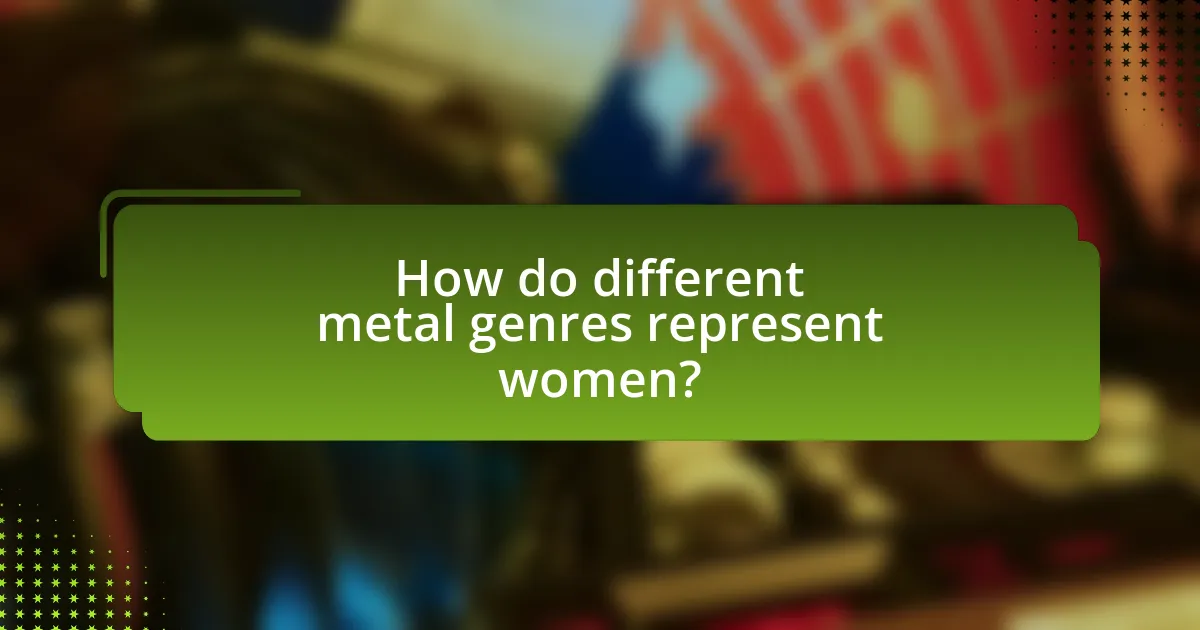
How do different metal genres represent women?
Different metal genres represent women in varied ways, often reflecting broader societal attitudes and the specific themes of each genre. In heavy metal, women are frequently portrayed as powerful figures, exemplified by artists like Doro Pesch and Angela Gossow, who challenge traditional gender roles and assert their strength. Conversely, in genres like glam metal, women are often depicted through a lens of sexuality and objectification, as seen in the imagery and lyrics of bands like Poison and Mötley Crüe.
In contrast, black metal tends to present women in more ambiguous roles, sometimes as muses or symbols of nature, while other times reinforcing misogynistic themes. Notably, the presence of female musicians in subgenres like symphonic metal, represented by bands such as Nightwish and Epica, showcases women as integral to the genre’s orchestral and lyrical depth, often embodying both strength and vulnerability.
Overall, the representation of women in metal is complex and multifaceted, influenced by the genre’s themes, cultural context, and the individual artists’ intentions.
What are the varying portrayals of women across metal subgenres?
Women are portrayed in diverse ways across metal subgenres, reflecting varying themes and cultural contexts. In genres like symphonic metal, women often embody ethereal and powerful figures, exemplified by artists such as Tarja Turunen of Nightwish, who combines operatic vocals with strong stage presence. Conversely, in genres like death metal, women may be depicted in more aggressive roles, as seen with bands like Arch Enemy, where Angela Gossow’s growling vocals challenge traditional gender norms. Additionally, in genres like power metal, female characters frequently represent fantasy archetypes, often as warriors or queens, which can be observed in the lyrical content of bands like Nightwish and Epica. These portrayals highlight the complexity of women’s roles in metal, ranging from empowered figures to those that reinforce stereotypes, demonstrating the genre’s multifaceted approach to gender representation.
How does heavy metal differ from other subgenres in its representation of women?
Heavy metal differs from other subgenres in its representation of women by often portraying them in more complex and empowered roles, as opposed to the more objectified or stereotypical depictions found in genres like pop or hip-hop. In heavy metal, women are frequently depicted as strong figures, capable of both aggression and emotional depth, which contrasts with the more traditional portrayals of women as passive or solely romantic interests in other music genres. For instance, female-fronted bands like Nightwish and Arch Enemy showcase women as leaders and powerful performers, challenging gender norms within the music industry. This representation is supported by the increasing visibility of women in heavy metal, with studies indicating that female musicians in this genre often gain respect for their musical talent rather than being solely defined by their appearance.
What role do female-fronted bands play in shaping genre perceptions?
Female-fronted bands play a significant role in shaping genre perceptions by challenging traditional gender norms and expanding the diversity of musical expression within genres. These bands often introduce unique perspectives and styles that can redefine audience expectations and broaden the appeal of specific genres, such as metal, rock, and punk. For instance, the presence of female vocalists in metal bands like Nightwish and Arch Enemy has not only garnered mainstream attention but has also influenced the genre’s evolution by incorporating melodic elements and lyrical themes that resonate with a wider audience. Studies have shown that female representation in music can lead to increased visibility and acceptance of diverse sounds, thereby altering the landscape of genre identity and audience demographics.
What themes are prevalent in lyrics and imagery related to women in metal?
Themes prevalent in lyrics and imagery related to women in metal include empowerment, sexuality, and resistance against societal norms. Empowerment is often depicted through strong female characters who challenge traditional gender roles, as seen in the works of artists like Arch Enemy and Nightwish. Sexuality is frequently explored, with imagery that can be both celebratory and objectifying, reflecting the duality of female representation in the genre. Additionally, themes of resistance are common, where women in metal confront issues such as misogyny and inequality, exemplified by bands like Jinjer and their lyrics addressing personal and societal struggles. These themes collectively illustrate the complex portrayal of women in metal, highlighting both their strength and the challenges they face within the music industry.
How do lyrical themes reflect societal views on women?
Lyrical themes in music often reflect societal views on women by portraying them through various stereotypes and roles that align with cultural perceptions. For instance, in metal music, women are frequently depicted as either powerful figures or as objects of desire, which mirrors broader societal attitudes towards femininity and empowerment. Research indicates that in genres like metal, female representation can range from strong, independent characters to submissive roles, illustrating the duality of societal expectations. A study by the University of Southern California found that female artists in metal often challenge traditional gender norms, yet still face objectification, highlighting the ongoing struggle for gender equality in artistic expression. This duality in lyrical themes serves as a reflection of the complex and often contradictory societal views on women.
What impact does visual representation have on women’s roles in metal?
Visual representation significantly impacts women’s roles in metal by shaping perceptions and challenging stereotypes. The portrayal of women in music videos, album covers, and live performances often influences audience expectations and industry standards. For instance, women depicted as strong, skilled musicians can inspire greater acceptance and recognition within the genre, as seen with artists like Lzzy Hale of Halestorm and Amy Lee of Evanescence, who have gained prominence through their powerful imagery and performances. Research indicates that positive visual representation correlates with increased participation of women in metal, as it fosters a more inclusive environment and encourages aspiring female musicians to pursue their careers in a traditionally male-dominated space.
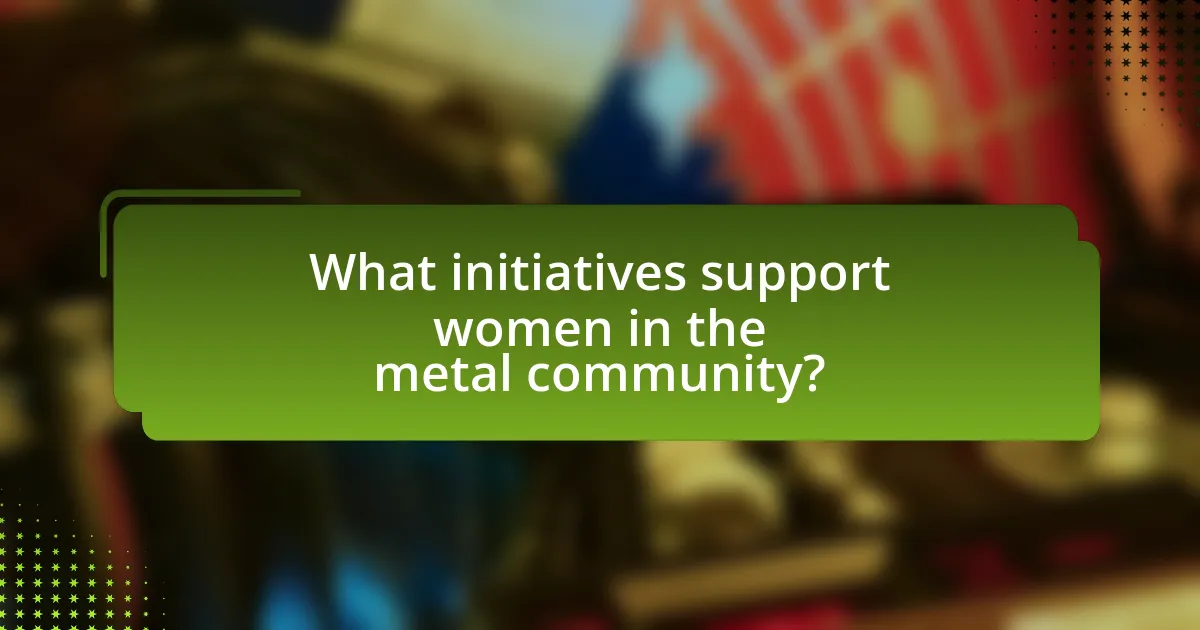
What initiatives support women in the metal community?
Initiatives that support women in the metal community include organizations like the Girls Rock Camp, which empowers young girls through music education, and the Women in Metal initiative, which promotes female artists and provides networking opportunities. Additionally, festivals such as the Femme Metal Fest showcase female talent in the genre, while social media campaigns raise awareness about gender equality in metal. These initiatives collectively aim to increase visibility, provide resources, and foster a supportive environment for women in the metal scene.
How do organizations promote gender equality in metal music?
Organizations promote gender equality in metal music by implementing initiatives that support female artists, create inclusive spaces, and raise awareness about gender disparities. For instance, organizations like the Women’s International Music Network (WIMN) and She Shreds Magazine actively provide resources, mentorship programs, and networking opportunities specifically for women in the metal genre. Additionally, events such as the Metal Women Festival showcase female talent and foster community engagement, while research indicates that increased visibility of women in metal can challenge stereotypes and encourage more equitable representation.
What resources are available for aspiring female metal musicians?
Aspiring female metal musicians can access various resources, including mentorship programs, online communities, and educational platforms. Organizations like Girls Rock Camp provide hands-on music education and support specifically for young female musicians. Online platforms such as She Shreds Magazine and Metal Injection feature articles, interviews, and resources tailored to women in metal, fostering a sense of community and visibility. Additionally, social media groups and forums allow female musicians to connect, share experiences, and collaborate. These resources collectively empower aspiring female metal musicians by offering guidance, networking opportunities, and a supportive environment.
How do mentorship programs influence women’s careers in metal?
Mentorship programs significantly enhance women’s careers in metal by providing guidance, networking opportunities, and skill development. These programs connect women with experienced professionals who can offer insights into the industry, helping to navigate challenges and build confidence. Research indicates that women with mentors are more likely to advance in their careers, as they receive tailored advice and support that addresses gender-specific barriers. For instance, a study published in the Journal of Music Business Research found that mentorship positively correlates with career satisfaction and progression for women in male-dominated fields, including metal music.
What can be done to improve gender representation in metal?
To improve gender representation in metal, the industry must actively promote female artists through targeted initiatives and support systems. This can include establishing mentorship programs that connect emerging female musicians with established artists, thereby fostering a supportive community. Additionally, festivals and venues should prioritize gender diversity in their lineups, as studies show that events featuring a balanced representation attract wider audiences and enhance the overall experience. Furthermore, media outlets should commit to equitable coverage of female artists, which can help challenge stereotypes and encourage more women to enter the genre. Research indicates that increased visibility leads to greater participation; for instance, a report by the Annenberg Inclusion Initiative found that female representation in music significantly impacts the likelihood of women pursuing careers in the industry.
How can audiences support female artists in the metal scene?
Audiences can support female artists in the metal scene by actively attending their shows and purchasing their music. This direct engagement not only boosts the visibility of female artists but also contributes to their financial success, which is crucial in a genre where female representation has historically been low. According to a 2020 study by the Annenberg Inclusion Initiative, women made up only 21.7% of artists in popular music, highlighting the need for increased support for female musicians. By promoting their work on social media, sharing their music with friends, and advocating for female artists in discussions about the genre, audiences can help create a more inclusive environment in metal music.
What strategies can venues and festivals implement for inclusivity?
Venues and festivals can implement strategies for inclusivity by ensuring diverse representation in their lineups, providing accessible facilities, and fostering a welcoming environment. Diverse representation can be achieved by actively booking female artists and underrepresented groups, which has been shown to increase audience engagement and broaden the cultural impact of events. Accessible facilities, such as ramps, designated seating, and gender-neutral restrooms, are essential for accommodating all attendees, as highlighted by the Americans with Disabilities Act, which mandates accessibility in public spaces. Additionally, fostering a welcoming environment involves training staff on inclusivity practices and creating policies that discourage harassment, thereby promoting a safe space for everyone. These strategies collectively enhance the overall experience and participation of diverse groups in the music scene.
What are the best practices for fostering a supportive environment for women in metal?
To foster a supportive environment for women in metal, it is essential to implement mentorship programs that connect experienced female musicians with newcomers. These programs can provide guidance, encouragement, and networking opportunities, which are crucial for building confidence and skills. Research indicates that mentorship significantly enhances career development and retention rates for women in male-dominated fields, including music. Additionally, creating inclusive spaces at events and venues, such as designated safe zones and anti-harassment policies, can help ensure that women feel welcome and respected. Studies show that environments promoting diversity and inclusion lead to higher participation rates and overall satisfaction among women in the industry. Furthermore, actively promoting female artists through festivals, playlists, and media coverage can elevate their visibility and representation, contributing to a more balanced gender landscape in metal music.
